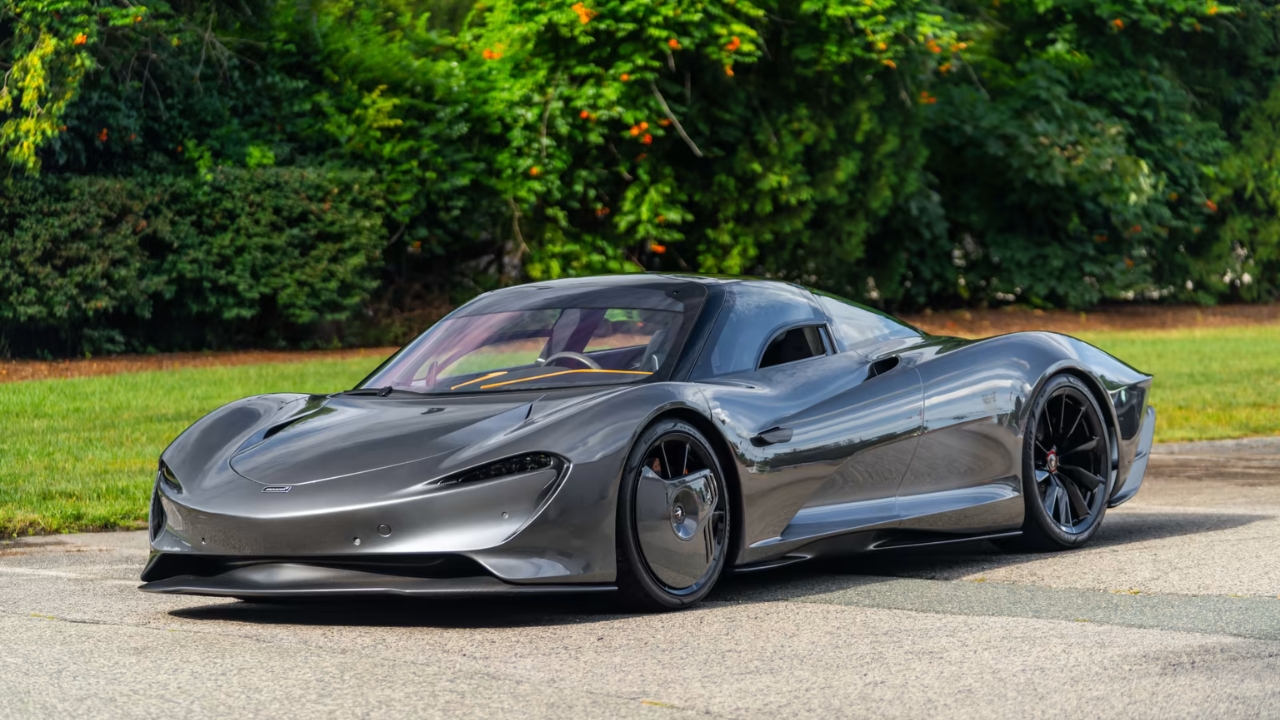Manufacturers constantly launch supercars, the epitome of automotive enjoyment. With only four years in the current decade, identifying the best among the many supercars takes time and effort.
However, we have narrowed down 13 of the most promising supercars of the 2020s, with six more years to go in this decade.
Rimac Nevera

The Rimac Nevera walks a fine line between supercar and hypercar, but there is no denying the performance it brings to the table. Thanks to the 120 kWh battery and four electric motors, the Nevera propels itself to a ridiculous top speed of 258 mph with a 0-60 mph time of just 1.85 seconds.
Those four electric motors and their battery pack give the Nevera the equivalent of 1,914 hp, making it one of the most powerful production cars on the planet. Rimac recently admitted that sales have been slower than hoped with the Nevera, although much of that could be attributed to its over $1 million price tag! However, there is no escaping the fact that the Nevera is a performance monster.
McLaren Speedtail

McLaren has yet to reinvent the wheel much with its supercars over the last few years, enabling it to produce some stunning machines. Their Speedtail, however, is a massive change for the company, as it follows in the footsteps of the mighty McLaren F1 thanks to the three-across seating arrangement with the driver in the middle.
The McLaren Speedtail, a testament to McLaren’s consistent excellence, is a game-changer for the company. With a twin-turbocharged V8 engine generating a staggering 1,035 hp and 848 lb-ft of torque, it can reach a top speed of 250 mph, making it the fastest British-built production car worldwide. Its aesthetic appeal is just the cherry on top.
McLaren Artura

The McLaren Artura, a subtle departure for the British manufacturer, retains its signature style while undergoing significant architectural changes. With a retuned chassis and electrical enhancements, it marks the first ‘all-new’ McLaren in years. The Artura’s new powertrain mounts enhance stiffness, and new aerodynamic ducting increases airflow, further enhancing its performance.
The mid-engine formula remains the same under the hood. The Artura boasts a new twin-turbocharged V6 hybrid powertrain with 690 hp and 531 lb-ft of torque. The electric motors also provide around 21 miles of range, perfect for a quick dash to the shops and back. While it may look similar to previous McLarens, that isn’t bad with the Artura.
Ferrari SF90 Stradale

The idea of a plug-in Ferrari hybrid might not appeal to some, but we are firmly in that territory with the SF90 Stradale. Yet it might be one of Ferrari’s best-ever supercars, with the trio of electric motors combining with the twin-turbocharged V8 engine to produce 986 hp in total, which rises to 1,016 hp in the XX version of the SF90.
The SF90 has the speed to back up those big performance numbers. It is no slouch, with a 0-60 mph time of just 2.0 seconds and a top speed of 211 mph. There is an EV range with the SF90, but it is minimal at just nine miles, so you will only get within town before you have to get the V8 to kick in and bring you home.
Ford Mustang GTD

Putting the Ford Mustang next to the term supercar might sound strange, but the soon-to-be-released Mustang GTD is a supercar version of the Blue Oval’s famous muscle car. Ford unveiled the GTD in 2023, taking everything that makes the 2024 Mustang range great to a new level.
The GTD is based on the GT3 racing version of the Mustang. The same version will take on the 24 Hours of Le Mans. Power is impressive, with the supercharged 5.2-liter V8 producing over 800 hp and adding a front splitter, rear wing, and more, which means the GTD will become an aerodynamic monster.
Lamborghini Sian

While the Lamborghini Sian’s hybrid element is a slight gimmick, its inclusion marked the beginning of a change at the supercar manufacturer. No longer was a fully hybrid Lamborghini an unrealistic prospect, and that incredible hybrid package was rolled into one of the best-looking supercars of the 2020s.
The small supercapacitor could only provide a brief burst of 34 hp, enough to bring the 6.5-liter V12 monster to 808 hp. It might be a gimmick, but the supercapacitor does help to smooth out the Sian’s savage gearshifts, making this Lamborghini one of the most enjoyable to drive of all modern Lambos. There is a lot to love about the Sian.
Maserati MC20

No one wants to see a name as iconic as Maserati’s struggle. Sadly, that is precisely what has happened with the Italian company, which has had a tough time over the past few years. But it was keen to put that behind it with the launch of the MC20, and if it is a sign of things to come, then Maserati’s future looks bright.
The first Maserati supercar since the MC12, the MC20, has a 3.0-liter V6 under the hood, complete with F1-grade pre-chamber combustion technology to boost its performance. The MC20 produces 621 hp and 538 lb-ft of torque and is easily one of the best-looking supercars of recent times. Maserati conceived and launched the MC20 in just two years, all while the world was trapped in the grasp of the COVID-19 pandemic.
Lotus Evija

The Lotus Evija is the biggest rival to the mighty Rimac Nevera. The British electric supercar is one of the most impressive of recent times, with a car that has four motors, four-wheel drive, and a staggering 1,972 hp. Lotus has worked with Williams Advanced Engineering to develop the battery technology to propel the car to a top speed of 217 mph.
The Evija is a minimal production car. The first one left the Lotus factory in August 2023 for its customer, 2009 F1 champion Jenson Button. Much work has gone into Evija, which is the perfect way for Lotus to launch its electric era. The brand is set to go all-electric, following the Emira sports car.
Chevrolet Corvette C8 Z06

Chevrolet turned the Corvette from a sports car into the supercar of the century thanks to the new 2023 Z06, following on from the C8 Stingray of 2020. This is the hottest Corvette in the history of the name, with the monster flat-plane-crank V8 engine churning out 670 hp and 460 lb-ft of torque.
What makes the C8 Z06 so impressive is that it churns out this power with no turbocharging, supercharging, or electric assistance. It is a naturally aspirated monster with a top speed of just under 200 mph and a 0-60 mph time of only 2.6 seconds. It might cost $110,000, but you get your money’s worth with that price tag.
SSC Tuatara

Despite the drama surrounding its 300 mph record-breaking run, the SSC Tuatara is an impressive piece of engineering. With a top speed of 295 mph, still speedy enough, power comes thanks to a twin-turbocharged 5.9-liter V8 that produces 1,750 hp on E85 ethanol fuel. The Tuatara is light, too, thanks to its carbon-fiber monocoque, and the Tuatara is slippery as well with the aerodynamic shape of the supercar.
The interior is also impressive, with leather and Alcantara throughout. Behind the steering wheel is a configurable instrument panel, and instead of side view mirrors, the Tuatara uses cameras, which also aid in the car’s aerodynamic performance.
McLaren 765LT

The McLaren 765LT is one of the most exciting of McLaren’s modern products. McLaren describes it as powerful, light, and track-focused, which is undoubtedly true thanks to its 205 mph top speed. The 4.0-liter V8 under the hood produces 755 hp and 590 lb-ft of torque, allowing the car to sprint to a 0-62 mph time of just 2.8 seconds.
However, the big selling point is the revisions done to the car’s handling. McLaren has shed weight from the 765LT compared to the 720S, and the vehicle also produces more downforce than the 720S. Revisions to the chassis and aerodynamics have allowed for fine-tuned handling, making the 765LT even more impressive. This is easily one of the supercars of the decade.
Gordon Murray T.50

While McLaren created a spiritual successor to the F1, its original designer, Gordon Murray, wanted to develop its true successor. Enter the GMA T.50, a stunning supercar with a massive fan at the back that sucks the T.50 to the ground. This is directly inspired by the Brabham BT46B F1 fan car that Muraray also designed.
Power comes from a Cosworth-developed naturally aspirated 3.9-liter V12 that produces 654 hp and 344 lb-ft of torque. The engine revs to 12,100 rpm and makes one of the best soundtracks of any modern performance car. The engine is an evolution of the V12 found under the hood of the Aston Martin Valkyrie, yet in the T.50, it feels entirely new as it sits inside one of the best modern supercars of all time.
Hennessey Venom F5

After the Hennessey Venom GT, the American tuning company recently stepped things up another gear with the incredible Venom F5. The Venom F5 is mind-boggling, with power coming from a 6.6-liter Fury twin-turbocharged V8 that produces a vast 1,817 hp and 1,193 lb-ft of torque.
Hennessey claims the top speed of the Venom F5 is a dizzying 301 mph and that the car can accelerate from 0-186 mph in just under 10 seconds. Thanks to the extensive use of carbon fiber, the Venom F5 is also light, weighing just 2,590 lbs. something we wish was true of practically every daily driver. There is an argument to make that the Venom F5 is currently the most impressive supercar of the decade.




